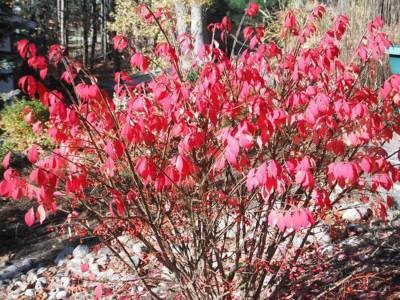My burning bush refuses to burn. A flat out refusal to blush and an earlier-than-usual letting go of leaves is decidedly perplexing. Two years ago, I planted a pair of euonymus in front of my house. After one winter, I moved them adjacent to my soaring blue spruce where they receive more sunlight than they did originally.
One of my euonymus is blushing modestly, while the other, wan and withering, seems ruined. But by what? Did an indelicate miscreant, bent on compromising the decency of this fair beauty, visit it in the night? Did it thus pluck her bounteous leaves, or poison her with hemlock? (Pardon my monologue — I tend to get Shakespearean when there is trouble in the garden.)
So far, according to my understanding of euonymus, I’ve done what I could to best prepare it for a solid life of performance and growth. Here are its present conditions:
It enjoys at least five hours of full sun (morning and late afternoon), even though on many a website, it states the burning bush can cope with full shade. I’ve always imagined though, that the more sun it enjoys, the hotter it’ll burn in the fall.
The soil is well drained and slightly acidic due to the massive spruce and its daily droppings. Seems this is the preferred conditions, yet again, I’ve read that come hell or high water, this bush can tolerate poor, compacted soils with varying pH levels. But a contradictory reading indicates that an alkaline soil may lead to poor chlorosis resulting in pale yellow or almost translucent leaves. And without sufficient chlorophyll, the leaves won’t turn red.
I use softwood mulch, which biodegrades slowly. A common ailment — nitrogen deficiency — can occur if you use hardwood mulch, which decays quickly and can deplete essential nitrogen from the soil beneath, ultimately depriving the plant’s roots of this important nutrient.
What I am worried about are the roots. Did I treat it too roughly when I transplanted? I tend to work quickly and perhaps less delicately than I should when I am moving things about. Often, I have so many on the go that I press on full throttle.
I can see no visible presence of scale, so I am convinced it must have something to do with its ability to absorb nutrients. Perhaps I might try testing the soil for a more accurate reading and then proceeding to amend the soil as necessary. Come to think of it, though, last year it was pale and wan as well. In fact, both of them were. Now this year, one is thriving. I’ll give it another full year and if I don’t see the proper amount of contrition, I’ll wash my hands of it completely.
Anne Boulton is an avid gardener who lives in Sudbury. Visit her blog at greenboots.ca or contact her at [email protected].
